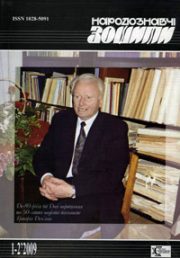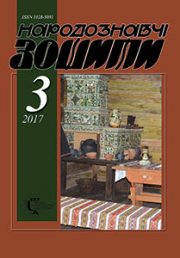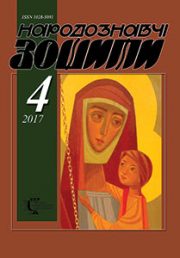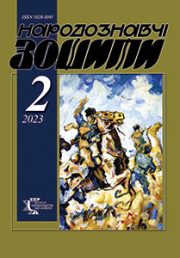The Ethnology Notebooks. 2018, 3 (141), 696–700
UDK 801.82:[398.8:81’276.3]:091″16/17″
DOI https://doi.org/10.15407/nz2018.03.696
«…THE MIXTURE OF SPIRITUAL AND FRIVOLOUS SONGS» IN THE MANUSCRIPTS OF THE BAROQUE EPOCH
Maierchyk Mariia, Ph.D. in History, Senior Researcher
at the Institute of Ethnology of the National Academy of Sciences of Ukraine.
The main editor of the scientific peer-reviewed journal
“Feminist Criticism: The Eastern European Journal of Feminist and Quir Studios.”
Deputy director of the Center for Cultural and Anthropological Studies.
Svobody Avenue 15, 79000, Lviv, Ukraine.
Contacts: mayerchykmaria@gmail.com
Abstrakt. This paper is an introductory review of the question discussed by historians of literature and culture since the 19th century, namely a presence of «bawdy» and «frivolous» songs next to spiritual texts in the early modern manuscripts. I argue for the necessity to historicize a concept of «bawdiness» and distinguish between modern (etic) and non-modern (emic) perception of «bawdy» songs in the Baroque epoch. This methodological move helps to provide a more nuanced understanding of the meanings and functions of these records. This approach facilitates developing a new perspective for the study of modernization in the sphere of language and intimacy.
Keywords: the 17th and 18th century manuscripts, baroque literature, modernization in the sphere of intimacy, «bawdy» songs.
Received 22.03.2018
References
Bajdin, V. (2013). Identifikacija Kirshi Danilova na Urale: materialy k biografii. Izvestija Ural’skogo federal’nogo universiteta, 4 (120), 47—70 [in Russian].
Vujtsyk, V. (1996). Hrafiti XVII—XV stolit’ tserkvy sviatoho Pantelejmona v Halychi. Zapysky Naukovoho tovarystva im. Shevchenka, (Vol. ССХХХІ, pp. 189—194) [in Ukrainian].
Hrushevs’ka, K. (1927). Zbyrannia i vydannia dum v XIX i v pochatka XX viku. In Ukrains’ki narodni dumy. (Vo. 1, XIII—CXXXII). Kyiv: Derzhavne vydavnytstvo Ukrainy [in Ukrainian].
Hrushevs’kyj, M. (1897). S’pivannyk z pochatku XVIII v. Zapysky Naukovoho tovarystva im. Shevchenka. (Vol. XV, pp. 3—48) [in Ukrainian].
Z aktovykh knyh XVII—XVIII st. (2013). In Boriak, O., & Maierchyk, M. (eds.). Etnohrafiia statevoho zhyttia j tilesnosti. (pp. 281—283), Kyiv: Tsentr kul’turno-antropolohichnykh studij [in Ukrainian].
Kalajdovich, K. (1818). Predislovie. Drevnіja rossіjskіja stihotvorenіja, sobrannyja Kirsheju Danilovym, i vtorichno izdannyja s pribavlenіem 35 pѣsen i skazok, doselѣ neizvѣstnyh, i not dlja napѣva. (I—XXXVI). Moskva: V tipografіi Semena Selivanovskago [in Russian].
Kljaus, V. (1995). Iz pesennyh sbornikov XVIII veka. In Russkij jeroticheskij fol’klor. Pesni. Obrjady i obrjadovyj fol’klor. Narodnyj teatr. Zagovory. Zagadki. Chastushki. (pp. 32—50, 543—548). Moskva: Ladomir [in Russian].
Krekoten’, V. (1987). Ukrains’ka literatura XVII st. In Ukrains’ka literatura XVII st. (pp. 5—25). Kyiv: Naukova dumka [in Ukrainian].
Peretc, V. (1905). K istorіi pol’skago i russkago narodnago teatra. (Nѣskol’ko intermedіj XVII—XVIII stolѣtіj). In Izvѣstіja Otdѣlenіja russkogo jazyka i slovesnosti Imperatorskoj Akademіi Nauk. (Vol. X. Kn. 1, pp. 51—104). Sanktpeterburg: Tip. Imp. Akad. nauk [in Russian].
Peretc, V. (1899). Malorusskіja virshi i pѣsni v zapisjah XVI—XVIII vv: I—XIV. (Otdѣl’nyj ottisk iz Izvѣstіj Otdѣlenіja russkogo jazyka i slovesnosti Imperatorskoj Akademіi Nauk, t. IV (1899 g.), kn. 3-j, 869—938). (pp. 1—70). Sankt-Peterburg: Tipografіja Imperatorskoj Akademіi Nauk [in Russian].
Pisarenko, Ju. (2005). «Zapretnyj» risunok iz Zolotyh vorot Kieva. Ruthenica, 4, 22—31 [in Russian].
Sheffer, P. (ed.). (1901). Sbornik Kirshi Danilova. Sankt-Peterburg: Tipografija Imperatorskoj akademii nauk [in Russian].
Camille, M. (2014). Dr Witkowski’s Anus: French Doctors, German Homosexuals and the Obscene in Medieval Church Art. In McDonald, Nicola. (ed.). Medieval Obscenities. (pp. 17—38). York: York Medieval Press.
Phillips, K., & Reay, B. (2011). Sex Before Sexuality: A Premodern History. Cambridge: Polity.
Uszkałow, Ł. (2011). Morfolohiia seksu v dzerkali ukrains’koi barokovoi literatury (prolehomeny). In Wielkie tematy kultury w literaturach słowiańskich. (Vol. 9, pp.509—524). Wrocław: Wydawnictwo Uniwersytetu Wrocławskiego [in Ukrainian].







